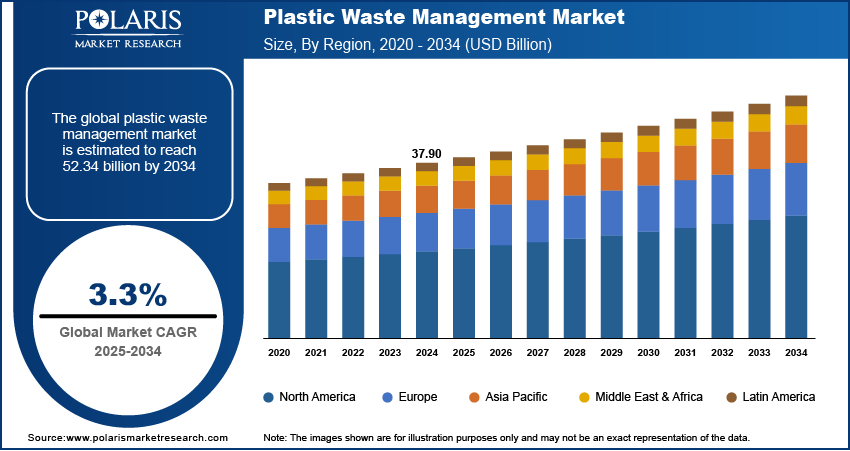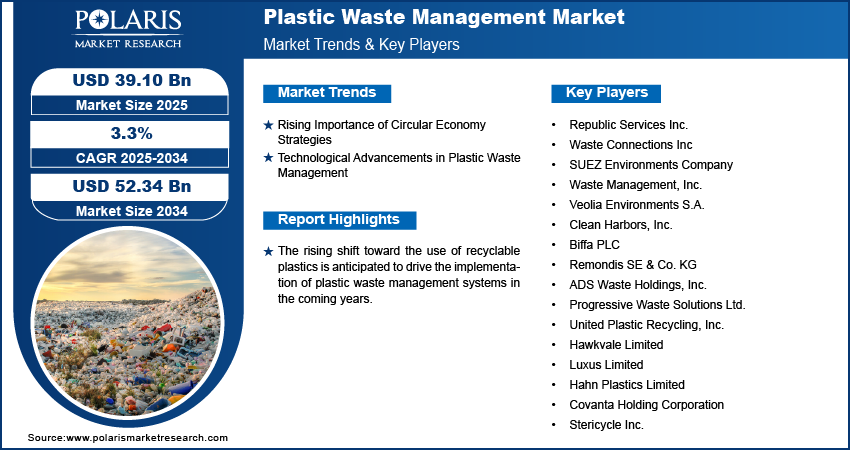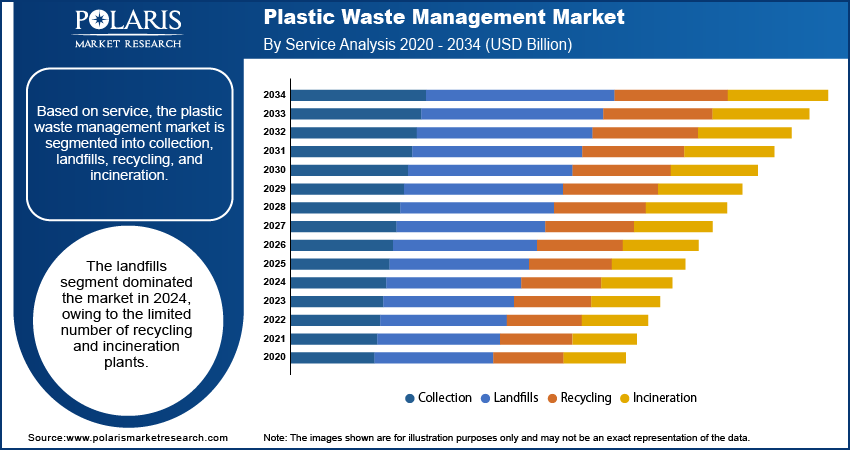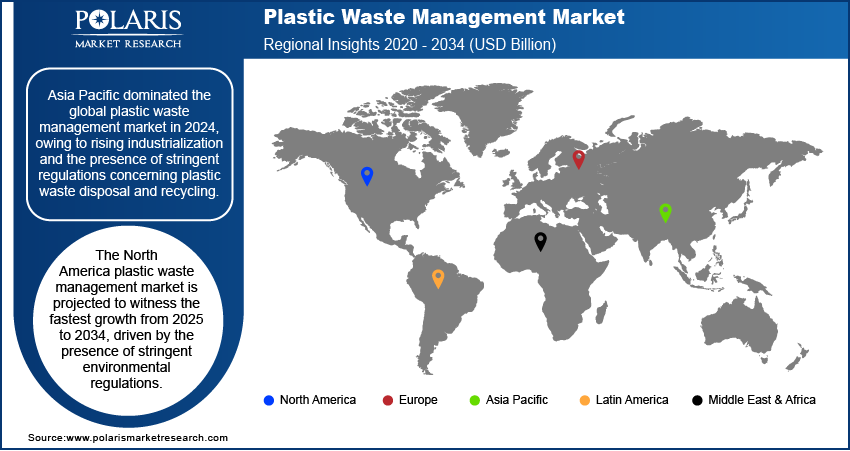
Plastic Waste Management Market Size, Share, Trends, Industry Analysis Report: By Service (Collection, Landfills, Recycling, and Incineration), Source, Polymer, End-Use Industry, and Region (North America, Europe, Asia Pacific, Latin America, and Middle East & Africa) – Market Forecast, 2025–2034
- Published Date:Jan-2025
- Pages: 115
- Format: PDF
- Report ID: PM1588
- Base Year: 2024
- Historical Data: 2020-2023
Plastic Waste Management Market Overview
The global plastic waste management market size was valued at USD 37.90 billion in 2024. The market is projected to grow from USD 39.10 billion in 2025 to USD 52.34 billion by 2034. It is projected to exhibit a CAGR of 3.3% from 2025 to 2034.
Plastic waste management is the process of collecting, processing, and disposing of plastic waste. It is a complex task that involves a variety of stakeholders, including businesses, governments, and individuals. Reprocessing plastics, sorting plastic waste, and segregating recyclable plastic are the key steps in managing plastic waste. Among these, recycling plastic waste is the most effective method of controlling plastic pollution. It helps reduce the production of additional plastic while also maintaining a low carbon footprint on the planet. Due to its versatility, recycled plastic can be used in the production of clothes, storage containers, films, garbage bags, and more. The effective implementation of a comprehensive plastic waste management system can reduce risks to public health and the economy and foster ecological preservation.

To Understand More About this Research: Request a Free Sample Report
Improved economic conditions, demographic and socio-economic changes, and environmental concerns are among the key factors influencing the plastic waste management market growth. Rising industrialization, growing urbanization, and increasing population in developed countries are other factors influencing the adoption of plastic waste management systems.
The shift toward the use of recyclable plastics, especially in food and beverage packaging, is a key trend anticipated to drive the implementation of plastic waste management systems. The introduction of stringent regulations by governments worldwide and rising initiatives to promote sustainable waste management practices are expected to provide numerous plastic waste management market opportunities during the forecast period.
Plastic Waste Management Market Dynamics
Rising Importance of Circular Economy Strategies
The circular economy system, which is based on the reuse and regeneration of products or materials, focuses on recycling and repurposing plastics. Globally, organizations are embracing circular economy models and making significant investments in recycling technologies for efficiently reclaiming, categorizing, and processing plastic waste. The shift toward the circular economy model is fueled by the need to reduce the dependence on nonrenewable resources and the incorporation of sustainability goals, which creates a sustainable value chain for recycled plastic. Thus, the growing emphasis on circular economy drives the plastic waste management market expansion.
Technological Advancements in Plastic Waste Management
In recent, there have been significant advancements in plastic waste management technologies. Advances in chemical recycling technologies, including pyrolysis and depolymerization, have enabled the recycling of complex plastics such as contaminated materials and multi-layered packaging. The use of artificial intelligence (AI) and machine learning (ML) in plastic waste management enables the segregation of plastics that were previously difficult to separate. Also, emerging waste-to-energy technologies for plastics are contributing to the circular economy. Thus, advances in plastic waste management technology are propelling the plastic waste management market development.

Plastic Waste Management Market Segment Insights
Plastic Waste Management Market Outlook by Service Insights
The plastic waste management market, based on service, is segmented into collection, landfills, recycling, and incineration. The landfills segment dominated the market with a revenue share of 47.5% in 2024, owing to the limited number of recycling and incineration plants. The landfill, which contains waste in compacted layers, is the primary method used for waste management globally. Landfills are used for the disposal of all waste types, including household waste, commercial waste, and nonhazardous sludge. The widespread presence of landfills contributes to their dominance in the market.
Plastic Waste Management Market Assessment by Source Insights
The plastic waste management market, based on source, is segmented into plastic bags, wrappers, plastic bottles, plastic containers & cutlery, industrial packaging, plastic caps and closures, and others. The plastic bags segment accounted for the largest market share in 2024. Plastic bags, being cost-effective and lightweight, are the preferred choice for carrying goods across several sectors, including food services, retail, and households. Their widespread usage leads to massive production and, consequently, to a significant amount of plastic waste.

Plastic Waste Management Market Regional Analysis
By region, the plastic waste management market report offers market insights into North America, Europe, Asia Pacific, Latin America, and the Middle East & Africa. Asia Pacific led the global market with a revenue share of 51.2% in 2024, owing to rising industrialization and the presence of stringent regulations concerning plastic waste disposal and recycling. Continuous economic growth, along with the rising emphasis on reducing the ecological footprint of companies, further propels the adoption of plastic waste management solutions in the region.
The North America plastic waste management market is projected to grow at the fastest rate from 2025 to 2034. The region is characterized by the presence of stringent environmental regulations, which drive the need for effective plastic waste management. Also, rising environmental consciousness about the impact of plastic waste on the environment among businesses, governments, and consumers is contributing to the plastic waste management market development in the region.

Plastic Waste Management Market – Key Players and Competitive Insights
The plastic waste management market research report encompasses a thorough vendor share research for all the major market players. The market for plastic waste management is highly competitive and has the presence of a large number of small and large vendors. The top market participants are introducing advanced solutions to cater to the growing customer needs. In addition, these companies are using strategic developments such as collaborations, partnerships, and mergers and acquisitions to enhance their offerings and expand their regional footprint.
To thrive in the competitive market environment, companies deliver plastic waste management solutions that are both efficient and cost-effective. A few of the key players in the plastic waste management market are Republic Services Inc.; Waste Connections Inc; SUEZ Environments Company; Waste Management, Inc.; Veolia Environments S.A.; Clean Harbors, Inc.; Biffa PLC; Remondis SE & Co. KG; ADS Waste Holdings, Inc.; Progressive Waste Solutions Ltd.; United Plastic Recycling, Inc.; Hawkvale Limited; Luxus Limited; Hahn Plastics Limited; Covanta Holding Corporation; and Stericycle Inc.
List of Key Players in Plastic Waste Management Market
- Republic Services Inc.
- Waste Connections Inc
- SUEZ Environments Company
- Waste Management, Inc.
- Veolia Environments S.A.
- Clean Harbors, Inc.
- Biffa PLC
- Remondis SE & Co. KG
- ADS Waste Holdings, Inc.
- Progressive Waste Solutions Ltd.
- United Plastic Recycling, Inc.
- Hawkvale Limited
- Luxus Limited
- Hahn Plastics Limited
- Covanta Holding Corporation
- Stericycle Inc.
Plastic Waste Management Industry Developments
April 2024: Luxus Limited announced the establishment of a new facility that focuses on the recycling and reprocessing of various plastic types. The company stated that the new plant will expand its capabilities in recycling plastic waste.
November 2023: Republic Services announced its collaboration with Blue Polymers, LLC for the development of the first plastics recycling complex in the US. The company stated that the complex will house Blue Polymers' advanced polymer production facility alongside the Republic Services polymer center. With the strategic move, the companies aim to promote plastic circularity and offer recycled materials for sustainable packaging and other applications.
Plastic Waste Management Market Segmentation
By Service Outlook
- Collection
- Landfills
- Recycling
- Incineration
By Source Outlook
- Plastic Bags
- Wrappers
- Plastic Bottles
- Plastic Containers & Cutlery
- Industrial Packaging
- Plastic Caps and Closures
- Others
By Polymer Outlook
- Polypropylene (PP)
- Polyvinyl Chloride (PVC)
- Low-density Polyethylene (LDPE)
- High-density Polyethylene (HDPE)
- Polyurethane (PUR)
- Terephthalate (PET)
- Polystyrene (PS)
- Others
By End-Use Industry Outlook
- Automotive
- Packaging
- Construction
- Wood and Furniture
- Textiles
- Others
By Regional Outlook
- North America
- US
- Canada
- Europe
- Germany
- France
- UK
- Italy
- Spain
- Netherlands
- Russia
- Rest of Europe
- Asia Pacific
- China
- Japan
- India
- Malaysia
- South Korea
- Indonesia
- Australia
- Rest of Asia Pacific
- Middle East & Africa
- Saudi Arabia
- UAE
- Israel
- South Africa
- Rest of Middle East & Africa
- Latin America
- Mexico
- Brazil
- Argentina
- Rest of Latin America
Plastic Waste Management Market Report Scope
|
Report Attributes |
Details |
|
Market Size Value in 2024 |
USD 37.90 billion |
|
Market Size Value in 2025 |
USD 39.10 billion |
|
Revenue Forecast by 2034 |
USD 52.34 billion |
|
CAGR |
3.3% from 2025 to 2034 |
|
Base Year |
2024 |
|
Historical Data |
2020–2023 |
|
Forecast Period |
2025–2034 |
|
Quantitative Units |
Revenue in USD billion and CAGR from 2025 to 2034 |
|
Report Coverage |
Revenue Forecast, Market Competitive Landscape, Growth Factors, and Trends |
|
Segments Covered |
|
|
Regional Scope |
|
|
Competitive Landscape |
|
|
Report Format |
|
|
Customization |
Report customization as per your requirements with respect to countries, regions, and segmentation. |
FAQ's
The market was valued at USD 37.90 billion in 2024 and is projected to grow to USD 52.34 billion by 2034.
The market is projected to register a CAGR of 3.3% from 2025 to 2034.
Asia Pacific accounted for the largest region-wise market size in 2024.
A few of the key players in the market are Republic Services Inc.; Waste Connections Inc; SUEZ Environments Company; Waste Management, Inc.; Veolia Environments S.A.; Clean Harbors, Inc.; Biffa PLC; Remondis SE & Co. KG; ADS Waste Holdings, Inc.; Progressive Waste Solutions Ltd.; United Plastic Recycling, Inc.; Hawkvale Limited; Luxus Limited; Hahn Plastics Limited; Covanta Holding Corporation; and Stericycle Inc.
The landfills segment held the largest market share in 2024.
The plastic bags segment dominated the market in 2024.
